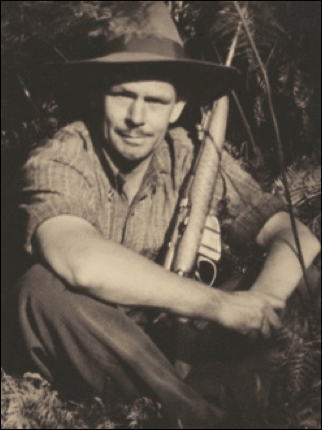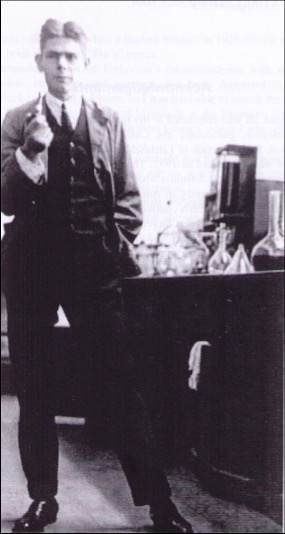Hedley Herbert Finlayson (1895 – 1991)

Hedley Herbert Finlayson (1895-1991) was born on 19 March 1895 in Adelaide, South Australia to Ebenezer Finlayson and his wife Finetta, née Champion (sister to Lizzie Martha Mills née Champion).
Hedley attended Kyre College, Unley (later to become Scotch College), prior to enrolling in science at the University of Adelaide.
In 1910 an explosives accident while he was a cadet in the chemical faculty injured his left hand. An article from the Advertiser of that time follows:
The Advertiser Friday 23rd September 1910
A SERIOUS EXPLOSION.
An accident happened on Wednesday
afternoon at Hawthorn to Hedley Finlay-
son, aged 15, second son of Mr. E. Finlay-
son. The youth is a cadet in the chemical
faculty, Adelaide University, under the
supervision of Professor Rennie. For some
weeks past Finlayson had been conducting
experiments in a little laboratory at his
home in connection with a new explosive
which he says he has discovered, and which
he claims is 20 per cent. more powerful
and more economical than any other now
in use. Wednesday was to witness the tri-
umph of his labors. A shell was being
filled and carefully tamped, when for
some unexplained reason a premature ex-
plosion took place. The tops of three
fingers and the thumb of the left hand
were blown away, the little finger was
burst open, and the palm of the hand was
severely lacerated.
Dr. F. S. Scott was quickly in attend-
ance, and conveyed the sufferer to the
Unley Private Hospital, where, assisted by
Dr. Russell, he performed an operation
which proved highly successful, and at an
early hour on Thursday morning the
patient was doing well. The lad has ex-
pressed the hope that the accident will not
incapacitate him from carrying out experi-
mental work in future. Much sympathy is
felt for the youthful scientist, and it is
hoped the accident will not spoil the pro-
mise of his career in chemical research.
In 1913 a second and more serious explosion occurred:
The Advertiser Monday 26th May 1913
A TERRIBLE EXPLOSION.
YOUNG INVENTOR'S HAND
SHATTERED.
ON VERGE OF SUCCESS.
With success almost at his hand, Mr.
Hedley Finlayson, of Dover-street, Mal-
vern, a promising young student, who had
been pursuing original investigations under
Professor Rennie at the Adelaide Univer-
sity for some time, was the victim of a
terrible accident on May 4 last. His ex-
periments have had to do with explosive
compounds, and some months ago he was
the victim of a serious explosion which
resulted in severe injury being done to
his hand. The accident, however, failed
to deter him and so soon as he had suffi-
ciently recovered he resumed the investi-
gations at the point at which he had left
them.
According to his professor, his researches
indicated unusual ability and enterprise,
and about three weeks ago it fitted that
everything was in readiness to make a pre-
liminary test of the explosive he had in-
vented. He chose May 4 for the day on
which the trial was to be made, and went
out to Glen Osmond to conduct the first
test in a spot where nobody could watch
the proceedings. He had every confid-
ence in the success of his invention, and
never dreamed of the possibility of mis-
hap.
The unexpected happened, however. A
hand-bomb was to be used for the first
test, and Mr. Finlayson was just screwing
in the percussion, cap when the explosion
occurred. It is assumed that friction
caused premature ignition. His left hand
was shattered, his right badly hurt, and
all the left side of his face and head was
frightfully injured.
In this terrible condition he walked to
Mr. J. Florey's house at Mitcham, where
Dr. Hilda Florey attended to him and
telephoned for an ambulance to take him
to the Adelaide Hospital. He was admitted
there by Dr. Dunstone, and Dr. Newland
performed an operation at once. He am-
putated the left hand at the wrist, and the
thumb of the right hand at the first joint,
and attended to the injuries to the head.
Since then the victim has been making
wonderful progress, and he is now able to
walk about the hospital grounds. One
eye is fortunately quite uninjured, and
though at first it was feared the sight of
the other would be entirely lost, it is now
hoped that it may be saved sufficiently to
allow it to be used with the aid of a
strong lens.
The doctors at the hospital all speak in
the highest terms of the fortitude dis-
played by Mr. Finlayson, who is only l8
years old, and, his courage has had much to
do with the splendid recovery he has
made.
This accident resulted in the loss of his left hand, right eye and the top of the thumb on his right hand.

A young Hedley in the science lab
He did not graduate but was well regarded within the University and was
appointed to the teaching staff in 1914. He worked largely as a chemistry
demonstrator until his retirement from that position in 1958.
From the early 1920s Hedleys primary interest had shifted to Australian mammalogy and in 1927 he was appointed honorary associate in Mammalia at the South Australian Museum. In 1930 he was appointed its honorary curator of mammals, a post he held until 1965.
Hedley travelled throughout many regions collecting Australian mammals. His most notable journeys were to outback South Australia and the Northern Territory. Between 1931 and 1935 he privately financed four collecting expeditions to these regions and they were conducted during the height of summer over the long university break as that was the only time Hedley could get off work.
Much of Hedleys early success came from working with local pastoralists and Aboriginal people and he also had the good fortune to be working at a time when many small to medium sized ground-dwelling desert mammals were still to be found. When he returned to central Australia in the 1950s he found that many of the species he had collected in the 1930s had either declined or disappeared completely, including the desert rat kangaroo and lesser bilby. Hedley was one of the earliest advocates of the need for large conservation reserves in outback Australia.
Hedley published his first scientific paper in 1920 and by 1963 had published a total of sixty three papers. Five of those papers were published in the international Nature magazine.
Hedley was also an accomplished landscape and natural history photographer, and took over five thousand negatives which are now housed in the Northern Territory Archives.
In 1935 Hedley published a book titled The Red Centre, a popular account of his work in Central Australia. This book has been reprinted eight times and is still used today by scientists & students in the study of natural history.
In 1960 Hedley was awarded the Royal Society of South Australia’s Verco Medal For his scientific work and in 1962 he was awarded the John Lewis Gold Medal of the Royal Geographical Society of Australasia (South Australian Branch) for his geographical research and writing.
Shortly before his death Hedley arranged for much of his private mammal collection to be transferred to Alice Springs, where it is now housed in the Museum of Central Australia. His collection of meticulously registered specimens and his many published papers remain highly regarded by scientists.
Hedley had never married and he died on 29 July 1991 at North Adelaide at the ripe old age of 97. His ashes are buried at the Mitcham General Cemetery.